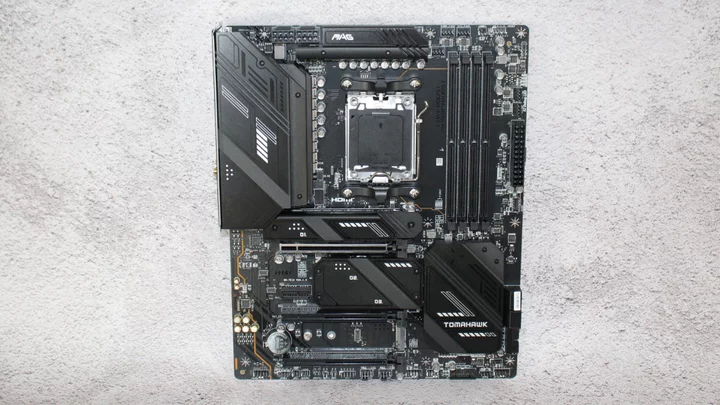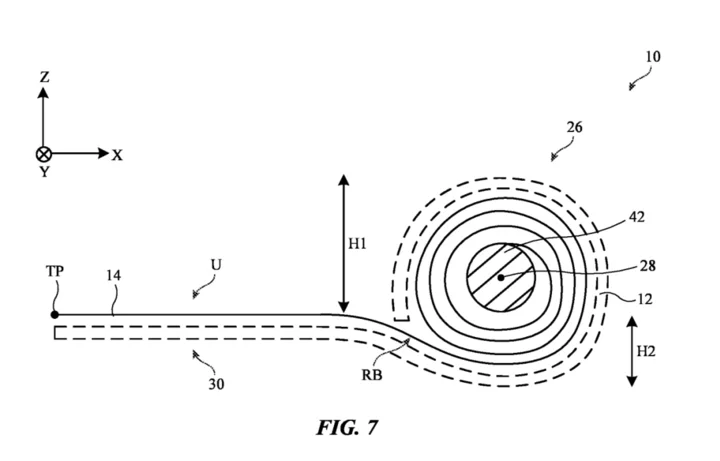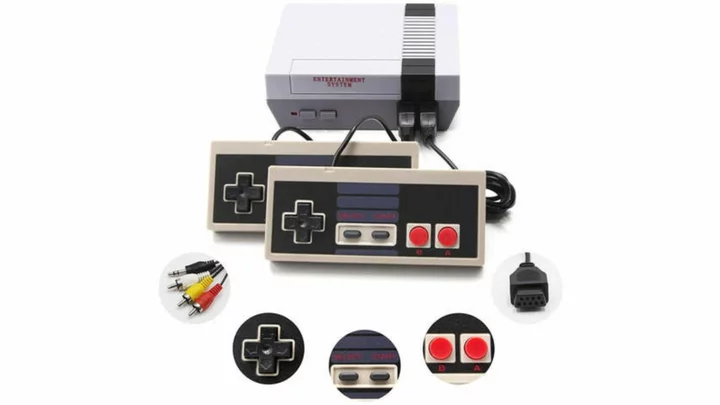If the AMD X670E chipset has a sweet spot, MSI's X670E Tomahawk motherboard is dead center. Priced at $329.99 MSRP (and currently less on MSI's online store and some online retailers), this ATX board offers ample storage including four M.2 sockets (one with PCI Express 5.0 x4 support); four SATA ports; fast Wi-Fi 6E and 2.5GbE networking; capable power delivery; a last-gen audio codec; and striking military styling in black with white accents. That's a lot to like for the price, and it earns our Editors' Choice award for its class: midrange AM5 X-series boards that don't go to excess.
Board Design, CPU, and Memory
The Tomahawk's ATX frame uses a matte black eight-layer PCB with matching heatsinks, sporting a military-themed design and brushed-aluminum finish. MSI applies some white stenciling to each heatsink for some eye-catching contrast. If you're expecting a light show out of the box, you'll be disappointed to learn the board does not have integrated RGBs, though it has plenty of headers for attaching your own RGB gear. Overall, it's a basic design with a fair amount of PCB showing but still a good-looking centerpiece for your AM5 build.
The board supports AMD's AM5 (Ryzen 7000 series) processors and is configured with 17-phase power delivery using robust 80A MOSFETs. With 14 phases dedicated to Vcore, the 1,120A available to the CPU can handle the flagship Ryzen 9 7950X we tested with, even when overclocked, so you have a free hand when picking a processor.
On the memory front, AMD's latest X670 and B650 platforms support only DDR5, so you can't pinch pennies as you can with Intel platforms that may have the option for DDR4 instead. MSI specifies RAM support up to DDR5-6600+ (OC), listing the Corsair and Oloy brands. However, your mileage may vary as reaching that speed depends on the memory kit and the quality of your CPU's integrated memory controller (IMC). At least DDR5 prices have been falling over the last couple of months, so its premium over DDR4 is shrinking.
As with most of our motherboard testing, we found our DDR5-5600 and DDR5-6000 kits proved stable by setting the XMP profile. All is well, at least around these (the current sweet spot) speeds. If you're into memory overclocking to squeeze out an extra percent or two of performance, the Tomahawk offers plenty of timings and sub-timings to tweak.
Layout and Internal Connectors
Starting at the top left of the motherboard, we first spy the dual 8-pin EPS connectors that power the processor. You can get by with using only one, but I suggest using both with high-end CPUs or overclocking due to the additional power draw. Surrounding them and the socket are two heatsinks designed to cool the power delivery below. They did a fine job keeping the VRMs running well within specifications on our test rig.
To the right of the socket area are four unreinforced DRAM slots with locking mechanisms on both sides. Above them you'll find two (of eight) 4-pin fan/pump headers. All headers support PWM and DC-controlled devices and output a whopping 3A/36W each, versus the usual mix of 1A and 2A headers. You won't have any problems running several fans and a water pump with such ample output.
In the right corner are two (of four) RGB headers, one 3-pin ARGB and one 4-pin RGB. You'll find the others along the bottom edge of the board, including a Mystic Light extension header that controls additional RGB peripherals without needing a separate controller. Control over attached devices can be found in MSI's Control Center and Mystic Light apps.
Moving down the right edge, we run into the EZ Debug LED, two more 4-pin fan headers, the 24-pin ATX power connector, and finally a front-panel USB 3.2 Gen 2 (10Gbps) Type-C header.
At lower left is the audio section, starring the last generation's midrange Realtek ALC1200 codec and a few audio capacitors. You won't find integrated DACs/amplifiers or a Faraday cage to mitigate EMI at this price point, but most users should find the MAG X670E Tomahawk's solution more than adequate.
In the middle of the board are three full-length PCIe slots and a single x1 slot. Two can be used for graphics cards, while the others are for expansion. Among the PCIe slots are four M.2 sockets, three of which have heatsinks to cool solid-state drives.
Finally, several headers across the bottom of the board include front-panel audio; additional RGB and ARGB headers (one apiece); two additional 4-pin system fan headers; another USB 3.2 Gen 1 (5Gbps) header; and two USB 2.0 headers. Last is the front-panel header to connect power and reset buttons—typical fare.
Expansion, Storage, and Rear I/O
As mentioned, the X670E Tomahawk has four PCIe expansion slots. The topmost, primary graphics slot (PCIE1, reinforced) connects through the CPU, delivering full PCIe 5.0 x16 bandwidth. The PCIE3 slot also connects through the CPU but passes PCIe 4.0 x4 lanes. The full-length bottom slot (PCIE4) and the x1 slot (PCIE2) source their lanes through the chipset and run at PCIe 4.0 x4 and 3.0 x1 respectively. That's plenty of bandwidth to go around.
Among the PCIe slots are four M.2 sockets. The top socket (M.21) receives its lanes through the CPU and runs up to PCIe 5.0 x4 (128Gbps), supporting modules up to 110mm long. I'm unsure how well its tiny heatsink will do with PCIe 5.0 drives, but life is an adventure. You'll probably want to rely on the SSD vendor's own active or passive cooling solution here if you install a 5.0 drive.
The other three M.2 sockets procure their lanes from the chipset, running up to PCIe 4.0 x4 (64Gbps) and supporting up to 80mm devices. There's some shared bandwidth worth mentioning: If there's a card installed in the PCIE4 bottom slot, the fourth M.2 socket runs at 4.0 x2 (32Gbps). You can run all four SATA3 6Gbps ports and all four M.2 sockets at the same time.
The rear I/O features a preinstalled backplate with a black background, gray labels for each port, and MSI MAG branding. From the left, you'll see a BIOS Flashback button and HDMI 2.1 and DisplayPort 1.4 ports for using integrated graphics. There are eight USB ports: two Type-C (one 20Gbps, one 10Gbps), four blue Type-A USB 3.2 Gen 2 (10Gbps), and two red Type-A 5Gbps. Just above one of the USB ports are the Realtek 2.5Gbps Ethernet port and the integrated Wi-Fi 6E antenna connections. A full-service audio stack including five analog ports and one digital/SPDIF port is on the right.
UEFI BIOS and Utilities
Like on most motherboards, MSI's BIOS starts in Easy Mode. It's both informative, with system details listed across the top, and functional, with the ability to change a few options including boot priority, XMP memory profiles, and Game Boost.
Unlike many rivals', the BIOS's advanced mode puts the major headings off to the sides instead of across the top, with details in the middle. The system summary remains visible up top.
In the Settings section, you'll find details on system, boot, and security functionality and adjust things like peripherals, USB, and graphics.
The OC page holds everything you need to tweak the processor and RAM. Users can manually overclock the CPU or adjust PBO settings for a canned (and recommended) experience. Like most motherboards in this class, the memory overclocking section gives you more timings than you can shake a stick at.
The Hardware Monitor section displays relevant system information ranging from CPU and motherboard temps to fan speeds and voltages. Within this section, you can adjust the fan speeds of the onboard 4-pin fan headers and set up custom profiles for all items attached to the headers.
Overall, MSI's BIOS proved as rich in options and as easy to navigate as its competitors'. The X670 platform allows complete control, so there are plenty of opportunities for hardcore tweakers. The system was eminently stable during our brief testing period.
As for software, MSI Center is a central app from which you can download and launch other applications including MSI Companion, Gaming Mode, Super Charger, and Mystic Light (for RGB control). It also offers hardware monitoring, though it lacks overclocking features.
The app's hardware monitoring is detailed, displaying CPU use, frequency, and temperature. It also lists several system temperatures, including DRAM, CPU, MOSFETs, and chipset, as well as critical voltages, but it doesn't let you tweak or adjust anything from here.
As I said, while the motherboard doesn't have integrated RGB lighting, it has four direct-connect headers and an integrated control header to add your own RGB bling for control via MSI's Mystic Light application. You can set profiles, sync RGBs, and adjust each component individually.
Verdict: An Admirable AMD Value
MSI's Tomahawk series motherboards have become household names for offering well-equipped, good-looking platforms at reasonable prices. For just over three C's, the X670E board continues this tradition, filling the spec sheet with features you'd expect including a full complement of PCIe 5.0 items (an x16 slot for graphics cards and an x4 M.2 socket); fast networking and competent audio; sufficient power delivery for AMD's flagship CPUs; and a look that fits with most build themes. Performance-wise, it mixed in well with comparable boards in productivity and gaming tests using a Ryzen 9 7950X processor.
If you don't mind supplying your own RGB decorations, the X670E Tomahawk easily earns a four-star review rating and our Editors' Choice nod for its class. It holds up well against the leading competition: Asus' TUF Gaming X670E-Plus Wi-Fi is a near match for $10 more, though at least on paper its audio solution is a bit better. ASRock's X670E Steel Legend also boasts a better audio codec but lacks Wi-Fi. The least expensive of the bunch at $279.99, the Gigabyte X670E Aorus Elite AX offers arguably the best looks but falls short on specs with only two M.2 sockets and no PCIe 5.0 connectivity. The MSI is a well-rounded motherboard that doesn't demand attention with glam and glitz but lets its hardware and price do the talking.









